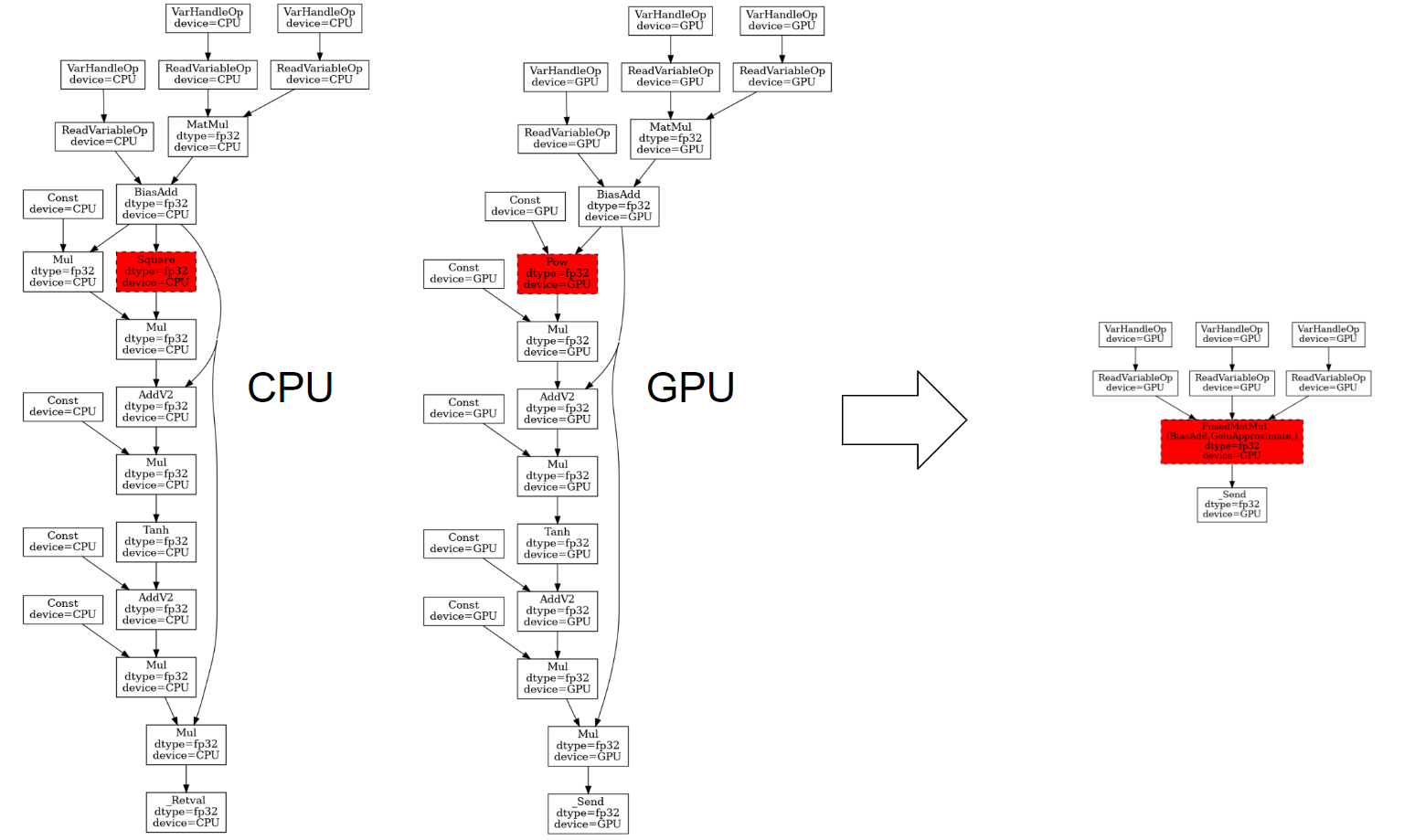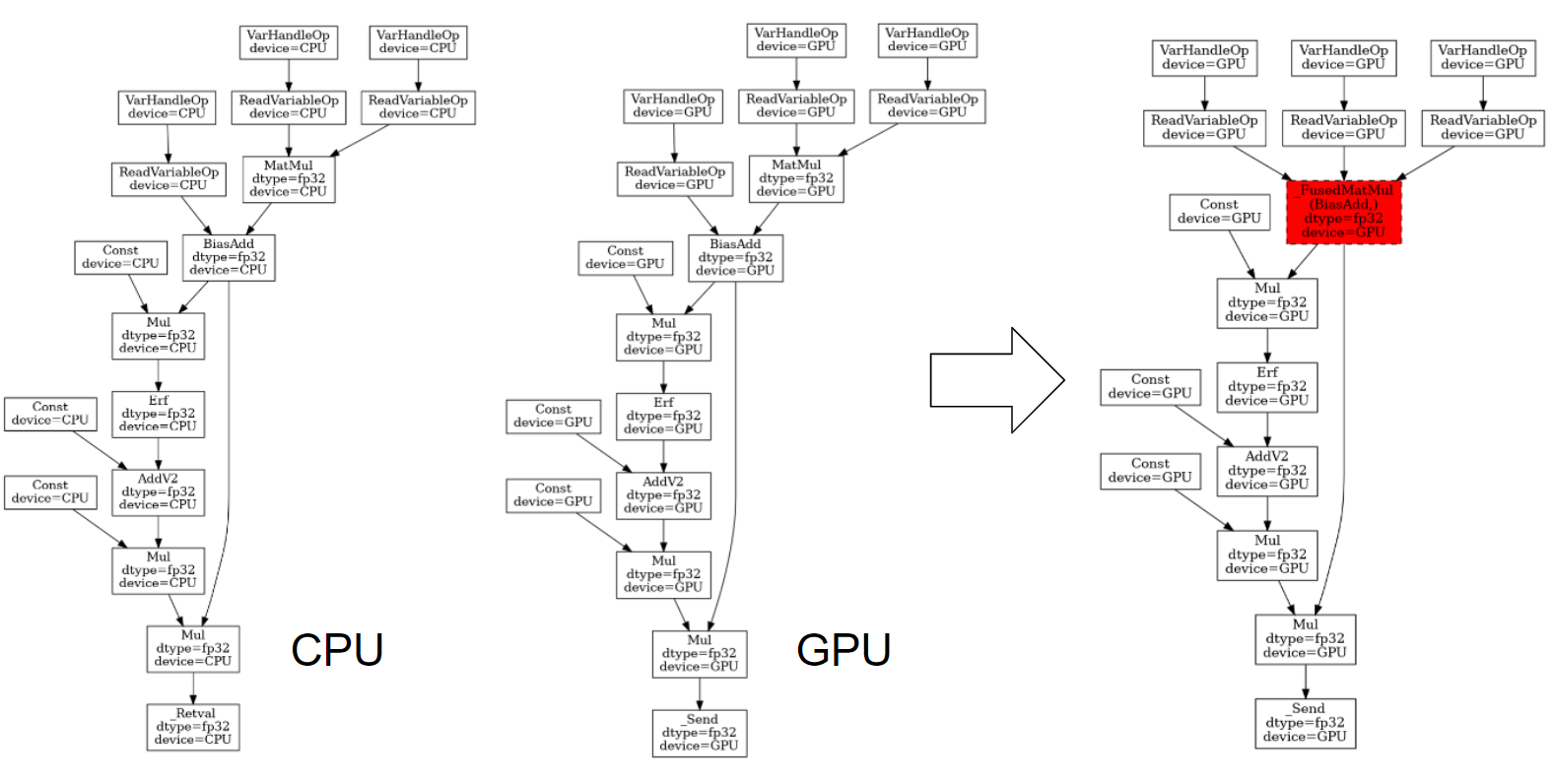CUDA Tips: nvcc’s -code, -arch, -gencode
Introduction People may feel confused by the options of -code, -arch, -gencode when compiling their CUDA codes. Although the official guidance explains the d...
This post focuses on the GELU activation and showcases a debugging tool I created to visualize the TF op graphs. The Gaussian Error Linear Unit, or GELU, is an activation function widely used in Transformer based models. It usually comes in with one of the two forms: exact or approximate:
Using GELU is pretty simply in the mainstream Deep Learning frameworks. For
example, in Tensorflow, users can call tf.nn.gelu(x, approximate=True) for the
approximate GELU over the tensor x. In this post, we will investigate what
will happen under the hood after the call and how CPU/GPU is going to optimize
this operation.
For me, the GELU function is quite exotic and not like other activation functions, such as RELU. The computation overhead of GELU is also much larger considering it is composed of many ops, e.g., addition, multiplication, tanh, erf, etc. Essentially, all these operations are pointwise operations and fortunately, the DL framework is able to fuse them as a single operasion (or less operations) by some graph optimization techniques. In TF, this is done via the TF grappler remapping pass. To better understand what patterns are matched, I created this visualizing tool to print out op graphs before and after any specified grappler optimization pass. Please check out the sample scripts in the repo which include the GELU examples and how to generate the graph pictures.
The following figures show the actual op graphs of MatMul->BiasAdd->GELU on
GPU and CPU. As we can see from the left-hand side (i.e. before remapping
optimization), there is actually no single op named GELU, but a bunch of Mul,
AddV2, etc. following the MatMul and BiasAdd.
It is worth noting the op graphs are a bit different on CPU and GPU for the
approximate GELU. In particular, CPU computes the x^3 by using mul(square(x),
x), while GPU simply calls pow(x, 3). This is actually done by the
arithmetic optimization (yeah, another grappler pass) probably because on CPUs,
the square() is much faster than the pow(). Whereas on GPUs, we would like
to save the device memory round-trip by calling a single op instead of multiple
ops.
In TF, both of above GELU patterns can be recognized and fused with the
preceding MatMul and BiasAdd by the grappler remapper. Under the hood, the
remapper conducts a DFS traversal to find a match from the root node (Mul) of
the pattern and the current node of the graph and recursively matches children
subpatterns and the children of current node. On the right-hand side of the
figure (i.e. after remapping optimization), we see a much clearer graph with
basically only one _FusedMatMul node. This can greatly improve the graph
execution performance by reducing the kernel launch and memory access overhead.
To enable this behavior, we need to turn on the cuBLASLt library
(TF_USE_CUBLASLT=1) on GPUs or use the MKL library on CPUs.
Fig 1. GELU Approximate Pattern Fusion

The op graphs of the exact GELU are same on CPU and GPU. Unfortunately, cuBLASLt doesn’t support this form of GELU at this point, so the TF can only fuse the MatMul and BiasAdd as a single op _FusedMatMul. In comparison, the MKL is able to recognize the exact GELU and replace all of them as a single op like in the case of the approximate GELU.
Fig 2. GELU Exact Pattern Fusion

Introduction People may feel confused by the options of -code, -arch, -gencode when compiling their CUDA codes. Although the official guidance explains the d...
When training neural networks with the Keras API, we care about the data types and computation types since they are relevant to the convergence (numeric stab...
Introduction This post focuses on the GELU activation and showcases a debugging tool I created to visualize the TF op graphs. The Gaussian Error Linear Unit,...
Introduction My previous post, “Demystifying the Conv-Bias-ReLU Fusion”, has introduced a common fusion pattern in deep learning models. This post, on the ot...
Introduction Recently, I am working on a project regarding sparse tensors in Tensorflow. Sparse tensors are used to represent tensors with many zeros. To sav...
Introduction On my previous post Inside Normalizations of Tensorflow we discussed three common normalizations used in deep learning. They have in common a tw...
Introduction Recently I was working on a project related to the operation fusion in Tensorflow. My previous posts have covered several topics, such as how to...
Introduction My previous post, “Fused Operations in Tensorflow”, introduced the basics of operation fusion in deep learning by showing how to enable the grap...
Introduction The computations in deep learning models are usually represented by a graph. Typically, operations in the graph are executed one by one, and eac...
Introduction Horovod is an open source toolkit for distributed deep learning when the models’ size and data consumption are too large. Horovod exhibits many ...
Introduction Recurrent Neural Network (RNN) is widely used in AI applications of handwriting recognition, speech recognition, etc. It essentially consists of...
Introduction Recently I came across with optimizing the normalization layers in Tensorflow. Most online articles are talking about the mathematical definitio...